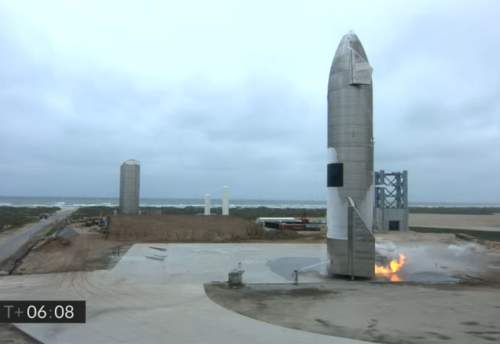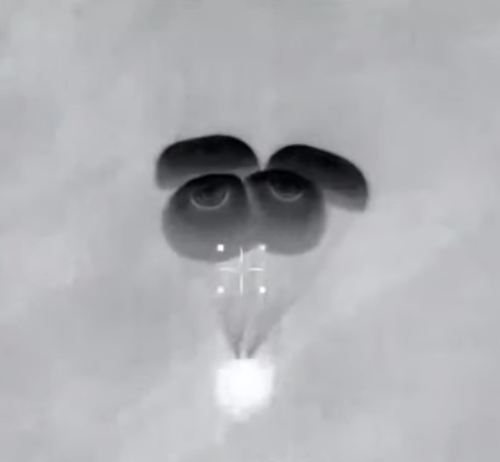May 5, 2021 Zimmerman/Batchelor podcast
Embedded below the fold in two parts.
» Read more
Embedded below the fold in two parts.
» Read more
Embedded below the fold in two parts.
» Read more
An evening pause: The main them form Mikis Theodorakis’ score from the movie Zorba the Greek (1964).
Hat tip Tom Biggar.


Capitalism in space: On the 60th anniversary of Alan Shepard’s suborbital flight, making him the first American to fly in space, SpaceX has successfully launched and landed its fifteenth Starship prototype.
The flight appeared remarkably smooth, except for the cameras on board which dropped out for much of the flight. The first image shows the rocket coming down just before touch down. At this moment it was dropping very smoothly, and landed very gently on the landing pad.
The second image was taken about thirty seconds after landing. There was a fire at the rocket’s base being extinguished by the water fire control system. Other than that, the rocket appears whole and undamaged.
As I write this, it is about ten minutes after landing, the fires at the rocket’s base have been put out, and all seems under control. I expect that SpaceX engineers will finally have a fully intact prototype that they can inspect for future design revisions. For example, the skin of this prototype has many thermal tiles attached. They can now see if their attachment system works.
I have embedded the 16 minute live stream of the flight below the fold. Enjoy!
» Read more

Screen capture from LabPadre Nerdle camera live stream.
UPDATED and BUMPED. The SpaceX live stream is now embedded below the fold. It is set to go live in about five minutes before launch, with the launch now set for about 5:25 pm (Central).
Capitalism in space: The roads have now closed at Boca Chica, Texas, in preparation for today’s test flight of SpaceX’s 15th Starship prototype.
The following live streams are presently available if you wish to watch:
I will add other live streams as they become available. If SpaceX adds its own live stream I will embed it below.
» Read more
Where are those alien civilizations? Breakthrough Listen, a privately funded project searching for evidence of alien life, has released the first results from its survey of 60 million stars in an area looking towards the galactic center, noting that it found no evidence of any technological transmissions signaling an alien civilization from any of those stars.
The paper can be downloaded here [pdf].
The kind of signals they were looking for were not beacons sent out intentionally by alien civilizations, such as television or radio broadcasts, but unintentional transmissions, such as radar transmissions meant for other purposes but still beamed into space. They found none.

Canceled at the University of Tennessee
They’re coming for you next: An offensive line coach at the University of Tennessee-Chattanooga (UTC), Chris Malone, was fired just two days after he posted a tweet strongly criticizing failed Democrat candidate for governor Stacy Abrams and her part in what the coach perceived as election fraud in Georgia.
He is now suing the school and the individuals involved in his firing.
Malone’s tweet:
Congratulations to the state GA and Fat Albert @staceyabrams because you have truly shown America the true works of cheating in an election, again!!! Enjoy the buffet Big Girl!! You earned it!!! Hope the money is good, still not governor!
The school’s immediate reaction:
» Read more
News you can use: A citizen science project has found that cats not only like to climb into real boxes, if you paint the illusion of a square on the ground they will prefer that spot as well.
The illusion at hand was the Kanizsa square: four pacman-like shapes orientated to look like they’re forming four corners of a square, inducing the viewer to perceive a square that isn’t actually there.
…Cognitive ethologist Gabriella Smith from the City University of New York and colleagues recruited humans to set up floor objects for their feline lordlings to choose from – a taped square, a visual illusion of a square, and the same components as the visual illusion, but not arranged to produce a square (the control).
The cat owners were required to film the cats’ response under reasonably controlled conditions to avoid influencing the animals’ choices (this involved wearing sunglasses, too). While over 500 pet cats were originally enrolled, the final data set shrunk down to 30 citizen scientists who managed to complete all the necessary trials.
…”The cats in this study stood or sat in the Kanizsa and square stimuli more often than the Kanizsa control, revealing susceptibility to illusory contours and supporting our hypothesis that cats treat an illusory square as they do a real square,” they found.
Need I add there because of the small sample there is a lot of uncertainty about these results. Though as far as the cats are concerned, there is no uncertainty at all: They rule, and their human servants shall obey.
The map above, reduced and adjusted to post here, shows today’s revised estimate by the Aerospace Corporation for where and when the 21-ton core stage of China’s Long March 5B rocket, launched on April 29th, will hit the ground. The reentry window has now narrowed to 22 hours, and is centered on May 8th at 10:29 pm (Eastern) over the Indian Ocean, just off the southwest coast of Australia. The yellow orbital tracks are after that centerpoint, while the blue are before. The tick marks indicate five minute intervals.
Expect these updates to come more frequently and continue to narrow in the next two days as the orbit continues to decay. Right now, if the stage comes down a little later than predicted there is ample opportunity for it to hit either Australia or the United States. Should it come down earlier, it right now could hit either Africa or Spain.
Note that the chances of this stage doing any real harm is quite slim, even it if lands on a populated area. It will break up during reentry so that any pieces that hit the ground will be much smaller. If anything, the debris will resemble somewhat the wreckage that fell when the space shuttle Columbia broke up over the U.S. in 2003 during its return to Earth. The impact of that wreckage injured no one on the ground, even as it did kill seven astronauts. Expect the same with China’s core stage.
The issue here is not the danger, but China’s gross negligence and violation of its treaty obligations in launching this rocket knowing the core stage was going to do this. No more Long March 5B launches can occur without them fixing the problem so that future core stages can be brought back to Earth in a controlled and safe manner.
Labaton Sucharow, a law firm that specializes in “representing clients in securities, antitrust, corporate governance and shareholder rights, and consumer cybersecurity and data privacy litigation,” has opened an investigation into Virgin Galactic’s decision on May 3rd to delay the release of its first quarterly report by six days.
Labaton Sucharow, a nationally ranked and award-winning shareholder rights law firm, is investigating potential securities violations and breach of fiduciary duty claims against Virgin Galactic Holdings Inc. (NYSE:SPCE).
On May 4, Virgin Galactic Holdings Inc. closed down over 9% on enormous volume after the space tourism company said it would restate certain past financial results in the wake of recent comments by the Securities and Exchange Commission on the accounting treatment of deals involving special-purpose acquisition companies.
The stock price is still falling, by the way.
Capitalism in space: Blue Origin announced today that it going to auction to the highest bidder the first tourist seat on the first New Shepard tourist flight, now scheduled for July 20, 2021, a little over two months from now. From the company^s website, where you can bid:
On July 20th, New Shepard will fly its first astronaut crew to space. We are offering one seat on this first flight to the winning bidder of an online auction.
There are three phases of the auction:
- MAY 5-19: Sealed online bidding – you can bid any amount you want on the auction website (no bids are visible)
- MAY 19: Unsealed online bidding – the bids become visible and participants must exceed the highest bid to continue in the auction
- JUNE 12: Live auction – the bidding concludes with a live online auction.
The winning bid amount will be donated to Blue Origin’s foundation, Club for the Future, to inspire future generations to pursue careers in STEM and help invent the future of life in space.
This is a very smart move, as it will generate some excitement and interest. It also schedules this private suborbital flight ahead of SpaceX’s first private orbital flight in September, allowing Blue Origin to upstage its rival somewhat.
It also is designed to help Blue Origin gauge the true interest in suborbital tourism. The final price will give them a good idea the right price to charge future passengers in order to sell the most tickets.
Finally, the timing of everything shows a nice historic touch. The announcement today took place on the 60th anniversary of Alan Shepard’s suborbital flight. The flight itself will take place on the 52rd anniversary of the Apollo 11 landing on the Moon.
Capitalism in space: Sierra Nevada today announced that it has now gotten clearance to land its Dream Chaser-class Tenacity spacecraft at the Kennedy Space Center, with a hoped-for first flight in ’22.
The Use Agreement makes SNC the first commercial user of Space Florida’s FAA Re-entry Site Operator License and provides the runway and support facilities needed during testing and landing. It also takes SNC one step further in applying for its own FAA re-entry license, something needed ahead of the first Dream Chaser mission next year.
Because Tenacity is a cargo freighter only, they do not plan a significant test program prior to that first launch to ISS.


The reentry window of the 21-ton core stage for China’s Long March 5B rocket, launched on April 29th, has now narrowed to only 28 hours, with the centerpoint of that window on May 9th over the Pacific, only about 20 minutes before reaching Mexico and the continental U.S.
The update by the Aerospace Corporation is shown in the maps above and to the right. With the right map I have zoomed into the section over the U.S. to show the potential path of this core stage should it come down a bit later than presently predicted.
The circled point is centerpoint of the reentry window. The yellow orbital tracks are after that point, with the blue tracks previous. The tick marks indicate 15-minute intervals.
As you can see, the centerpoint is only about 20 minutes before the stage crosses Mexico and begins a half hour traverse above the continental United States from Texas to Maryland. If the stage should manage to stay up for another full orbit it will once again traverse the continental U.S., this crossing from San Diego to Cape Cod.
If the stage comes down early instead it could land anywhere from southern Europe to Australia, with the Middle East and India in between.
As I have noted already, China designed and launched this rocket knowing it was creating a giant piece of space junk that was going to fall on someone’s head. Just as that communist government has not cared that it has been dumping first stages on its own people for decades, it apparently does not care that it is dumping even bigger first stages on everyone else. The Long March 5B is the rocket they are using to launch the modules to their space station, as well as many of the future planetary missions to the Moon and Mars. And every time they launch it they will be dumping a core stage on someone, a direct violation of the Outer Space Treaty that China has signed.
The world’s governments should be outraged, and teaming up to demand that either China change this situation or delay future Long March 5B launches, or face serious financial consequences. Sadly, I do not expect this, as our present political class is either incompetent or corrupt and in the deep financial pockets of the Chinese.
Cool image time! The photo to the right, cropped and reduced to post here, was taken on January 29, 2021 by the high resolution camera on Mars Reconnaissance Orbiter (MRO). It shows what the science team labels as “Fresh Shallow Valleys”. The section I have focused on shows a particularly interesting meander next to a small crater. The full image shows additional similar channels to the north, with one draining into a larger 3.7 mile wide crater.
The location is in the southern cratered highlands, at about 41 degrees south latitude, where much evidence of buried glacial features are found. That certainly is what we appear to see here. In fact, the wider view afforded by MRO’s context camera reveals many more such channels. That wider view also shows a much larger 18-mile-wide crater just to the north that appears filled with buried ice.
That the scientists label these fresh suggests they think they are relatively young, probably dating from when the most recent cycle of glacial growth probably ended. This would make them about 6 million years ago, based on this paper [pdf] and the second figure from that paper below.
» Read more
Capitalism in space: SpaceX today successfully launched another 60 Starlink satellites into orbit, using its Falcon 9 rocket.
This raises the number of Starlink satellites to more than 1,600. The first stage also landed safely, completing its ninth flight.
The leaders in the 2021 launch race:
13 SpaceX
11 China
7 Russia
2 Rocket Lab
The U.S. now leads China 18 to 11 in the national rankings.

Show trials: Debate as Twitter sees it.
Blacklists are back and Twitter’s got ’em: Rather than write today about a single specific individual being blacklisted and destroyed by today’s intolerant left, let’s take a look at one of that left’s most intolerant and oppressive blacklister, Twitter.
Like all the big tech social media companies such as Google and Facebook, Twitter is essentially run like a leftwing fiefdom. Though it allows conservative writers to post there, it makes it very clear that they are always under a probation that can be withdrawn immediately if someone in company’s workforce finds itself offended or disagreeing with something that conservative posted.
For example, in January religious radio host Michael Brown got banned from Twitter for twelve hours for simply posting a tweet where he asked this simple question: “Will I get punished by Twitter for saying that, in God’s sight, ‘Rachel’ Levine (nominated by Biden to be his assistant secretary for HHS) is a man?”
» Read more
Capitalism in space: Firefly announced today that it has raised an $75 million in investment capital, with plans for a future fund-raising round aimed at bringing in another $300 million following the inaugural launch of its Alpha rocket.
The launch itself has been delayed several times, from December and March. It now appears they are targeting mid-June.
The company claims the delays were caused by two factors, the failure of a subcontractor to deliver on time the flight termination system, and the company taking longer than expected to prepare its launchpad at Vandenberg.
On a positive note, the company received its FCC launch license a few weeks ago, which had been held up due to security concerns over the company’s former main investor, Ukrainian billionaire Max Polykov. It appears that when Polykov sold off much of his stock so that he no longer controls the company, this eliminated the security concerns.
Capitalism in space: While there appear to presently be about 100+ new rocket company startups competing to garner market share in the growing satellite launch industry, it appears there is only one startup, Ursa Major Technologies, focused solely on building rocket engines for those rockets.
The company’s business model is based on the idea that while many launch providers make their own propulsion systems, others will choose outsourcing so they don’t have to invest money and time in risky engine development.
It presently has a small engine, dubbed Hadley, that is set to launch on another company’s rocket in ’22, and a larger engine, dubbed Ripley, that is being developed and has a contract for use by the new rocket startup Phantom Space.
In a sense this company is conceivable in competition with Momentus, which builds and sells a space tug, essentially an upper stage engine, for moving smallsats from one orbit to another. Both are aiming for a niche within the new smallsat industry by providing rockets and satellites engines.
If the industry grows as big as hoped, both will likely have plenty of business.
The core stage of NASA’s SLS rocket has arrived in Florida and has now begun the processing to get it ready for launch anywhere from six to ten months from now.
Approximately six months of work is anticipated to finish assembly and complete a long series of tests and checkouts of SLS and the Orion spacecraft it will send to the Moon, but current forecasts of this first-time integration work estimate closer to ten months to complete the necessary operations. After the vehicle is put together, weeks and weeks of testing to make sure SLS and Orion are properly talking to each other, as well as the EGS ground infrastructure, will follow.
…Recent schedules showed the remainder of work to reach launch readiness extending for ten months once the core stage arrived. That time includes six months of operations to the “work to” launch readiness and four months of “risk factor”. The “work to” launch readiness date, which would still have to synchronize to a lunar launch window, is currently early-November 2021. With risk factored in, a date of early-March 2022 is derived.
NASA has not yet changed that November ’21 target for launch, though all reports strongly suggest it cannot be met.
Regardless, even if they can get this thing launched by November, the long prep time shows once again how cumbersome and inefficient this rocket would be if anyone tried to use it to explore space. NASA says that after this first launch the prep time will be shorter, but even if it is trimmed to three months (the best estimate I’ve seen) it simply isn’t good enough. SpaceX has already demonstrated that is can fly two different Starship prototypes in less than thirty days (with #10 flying March 3rd and #11 flying March 30th). The company’s goal is many flights frequently, and it so far is proving that this goal will be achievable. And it will do it placing more payload in orbit for pennies (compared to the cost of SLS).
I still predict that there is a better than 50% chance that the first orbital launch of Starship/Superheavy will occur before SLS, even though the former began actual hardware development only two years ago.
I also think that we are now in the final stages of the entire SLS program. As with all similar big NASA-led rocket projects started since the mid-1980s, it will die stillborn. The previous projects never even got built after spending billions on blueprints and powerpoint presentations. SLS will likely get at least two flights (assuming nothing goes wrong with the first). After that NASA and the federal government will shut it down because by that time there will be far better and cheaper options available.
An evening pause: I honestly don’t understand how this works, and the video doesn’t really explain it. It is quite amazing nonetheless. More information here if you want to dig about to figure it out.
Hat tip Cotour.

Banned by the Biden administration
Blacklists are back and the Dems’ have got ’em: Routinely called a racist, bigot, white supremacist, and (of course) an alt-right conservative by the mainstream press, controversial Nick Fuentes’ track record is far from that straight-forward. Though it appears he has often taken some ugly positions and made some even more ugly statements, he apparently has never done anything illegal or outright bigoted.
No matter to the Biden administration and the TSA. They have blacklisted him, banning him from flying on any American airline.
Moreover, the federal government is not the only one blacklisting Fuentes because they don’t like his opinions. As Fuentes himself noted in a April 27th tweet:
Since attending President Trump’s rally on the Ellipse on January 6th I’ve been:
-Banned from AirBnB, Facebook, Instagram, DLive, and Coinbase
-Banned from every payment processor
-Had a bank account frozen
-Put on the no-fly listAnd I haven’t even done anything wrong!
The most important line in his tweet is the last one. What he has said might be wrong-headed, bigoted, or stupid, but in a free country that defends its first amendment, he would be within his rights to say it, and would have broken no laws by doing so.
We no longer live in that long gone free nation. Now we live in a place that routinely uses power to squash radical positions, except when those opinions happen to be leftist radical positions. Those Marxist opinions are always blessed with immunity, no matter how bigoted or vile. In fact, if you dare to criticize the dominant Marxist and bigoted culture in any way at all, you are guaranteed to be called a bigot and are likely to be blacklisted, like Fuentes, for doing so.
I’ve said it before and I’ll say it again. Mars is strange, Mars is wonderful, but above all, Mars is alien. Today’s cool image illustrates this saying quite nicely.
The photo to the right, cropped and reduced to post here, was taken on February 1, 2021 by the high resolution camera on Mars Reconnaissance Orbiter (MRO) and was simply labeled “Sacra Sulci Lava”. Sacra Sulci is a section of the Kasei Valles canyon that runs from the north rim of Valles Marineris north about 600 miles where it turns east for about 400 miles to drain out into the northern lowlands plains of Mars. Sacra Sulci is the region where that valley narrows and then turns east.
Apparently the flat smoother areas on the east and south on this image that rise about 60 feet above the surrounding terrain and that also seem to flow around mesas and into canyons are believed to be the edge of a massive lava flow that occurred about 150 to 200 million years ago and drained through Kasei Valles, just like water.
What makes this puzzling, however, is that everything I had read previously about Kasei Valles said that it was thought to have been formed from catastrophic floods of water on early Mars, when the planet was warmer and wetter. In fact, I had posted previously about this theory, and included the map below, taken from figure 8 of this paper [pdf], showing part of the process that some scientists believe occurred.
» Read more
According to estimates this morning by the Aerospace Corporation, the 21-ton core stage of China’s Long March 5B rocket will come crashing down to Earth sometime on May 10th, plus or minus 41 hours.
Their map to the right illustrates all the orbits that will take place during that time period, which in turn shows all the possible places that core stage might land. For example, though the center point in that time period puts the stage down in the Pacific west of South America, should it go down just a little more than two orbits later it will then be crossing over the entire continental United States, with even a very slim chance it could land on my own house in Arizona! If it should come down a little early instead it could land on Europe, the Middle East, India, or Australia.
This estimate is very very uncertain, and will be refined in the days ahead, though because of the chaotic nature of decaying orbits it will be impossible to refine it to less than half an orbit, even on the day of its return.
Nor can anyone do anything about it. Large sections of this big piece of hardware is going to hit the ground in an uncontrolled manner. And China, a signatory to the Outer Space Treaty which forbids exactly this sort of uncontrolled reentry, launched it anyway.
Waiting for Godot: Even as Blue Origin is finally about to announce the start of commercial ticket sales for its New Shepard suborbital spacecraft, Virgin Galactic has delayed release of its first quarter earnings report so that it will be released after, not before, that Blue Origin announcement.
Virgin Galactic claims the six day delay is in order to adjust numbers due to a new SEC requirement announced in mid-April. However, placing it after Blue Origin’s announcement instead of just the day before minimizes what would have been a very ugly-looking public relations disaster.
Whatever the actual reason for the delay, the prospect of delivering yet another dismal earnings report only hours before Blue Origin’s announcement could not have been an attractive one for Virgin Galactic CEO Michael Colglazier and new CFO Doug Ahrens. The quarterly earnings call is a major opportunity to influence Wall Street analysts who make recommendations on whether to buy or sell the company’s stock.
Virgin Galactic is expected to report a significant loss with minimal or no revenues as it struggles to complete the flight test program for its SpaceShipTwo suborbital vehicle, VSS Unity. Virgin Galactic’s net lost was $273 million for 2020, including a $74 million net loss for the fourth quarter.
Virgin Galactic’s stock has been taking a pounding lately. After opening at $10.75 on the first day of trading on Oct. 28, 2019, the stock soared to a high of $62.80. It is now trading at $22.15, having lost all of its gains for the year.
That both Richard Branson, the company’s founder, and Chamath Palihapitiya, the big investor when the company went public, have both sold off large portions of their stock in the past few months has also contributed to the bad press. Both took advantage of the high stock prices and apparently got out when the getting was good.
I fully expect this company to fail in the next year or two. If it doesn’t it surely will never achieve any of the many grandiose promises put forth by Branson for almost two decades.
The uncertainty of science: On May 1st NOAA updated its monthly graph to show the Sun’s sunspot activity through the end of April 2021. As I do every month, I have annotated it to show the previous solar cycle predictions and posted it below.
In my sunspot update last month I reviewed in detail the range of predictions by solar scientist for the upcoming solar maximum, noting that based on the higher than expected sunspot activity that has been occurring since the ramp up to solar maximum began in 2020, it appeared that all of their predictions might be wrong. The continuing high activity that occurred in April continued that trend.

Capitalism in space: SpaceX’s Resilience capsule successfully splashed down tonight in Gulf of Mexico, returning four astronauts from a six month mission on ISS.
The infrared image to the right was taken from an airplane, just after the main parachutes deployed.
They are presently in the process of recovering the capsule and crew, which will take another hour or so. You can watch SpaceX’s live stream here.
Resilience’s next flight will be the first entirely commercial manned orbital flight, presently scheduled for September 15, 2021. Dubbed Inspiration4, it will carry four private passengers for a flight of two to four days. They will not dock with ISS, but instead orbit the Earth freely. SpaceX will also replace the docking port on Resilience with a domed cupola to provide the passengers more room and a great view during their flight.
Capitalism in space: Because of weather delays, SpaceX will now attempt the splashdown of Resilience carrying four astronauts from ISS in the predawn hours tomorrow, the first nighttime splashdown in more than a half century, since Apollo 8 in 1968.
Resilience will undock from ISS tonight at 8:35 pm (Eastern), and splashdown in the Gulf of Mexico at 2:57 am (Eastern).
This will also be only the third nighttime landing ever. Besides Apollo 8, which was planned, in 1976 Soyuz 23 failed to dock with the Soviet Union’s Salyut 5 station and came home after only two days in space. That unplanned landing also turned out to be the first and only manned splashdown ever in Russian history, as the capsule landed on frozen Lake Tengiz in Kazakhstan, breaking through the ice, during a blizzard. The two astronauts were safely recovered, though their return to Earth was far from pleasant.
China yesterday successfully launched an Earth observation satellite using its Long March 4C rocket from its interior Jiuquan Satellite Launch Center in inner Mongolia. Its first stage, using toxic fuels, will fall on land somewhere in China.
The leaders in the 2021 launch race:
12 SpaceX
11 China
7 Russia
2 Rocket Lab
The U.S. still leads China 17 to 11 in the national rankings.
For the second time in two launches, the 21-ton core stage of China’s Long March 5B rocket is about to make uncontrolled re-entry, with a mass large enough that some part of it is certain to hit the ground.
Where and when the new Long March 5B stage will land is impossible to predict. The decay of its orbit will increase as atmospheric drag brings it down into more denser. The speed of this process depends on the size and density of the object and variables include atmospheric variations and fluctuations, which are themselves influenced by solar activity and other factors.
The high speed of the rocket body means it orbits the Earth roughly every 90 minutes and so a change of just a few minutes in reentry time results in reentry point thousands of kilometers away.
The Long March 5B core stage’s orbital inclination of 41.5 degrees means the rocket body passes a little farther north than New York, Madrid and Beijing and as far south as southern Chile and Wellington, New Zealand, and could make its reentry at any point within this area.
The previous core stage hit the Atlantic Ocean six days after launch in May 2020. Had it come down fifteen to thirty minutes earlier it would have come down on U.S. soil, possibly even on top of the New York metropolitan area.
China’s design for this rocket means that every single launch will result in similar potential disasters. They cannot restart the core stage’s engines after cut-off, so that once it has delivered its payload it is nothing more than a very big and uncontrolled brick that has to hit the ground somewhere.
This is a direct violation of the Outer Space Treaty, which China is a signatory. The treaty makes signatories liable for any damage from an uncontrolled re-entry, and requires them to take action to prevent such events from occurring.
China it appears doesn’t care much about the treaties it signs. The first time could be rung up to a mistake. The second time is intentional and tells us that this country will not honor any of its obligations anywhere else, if it decides it can get away with it.
Embedded below in two parts.
» Read more